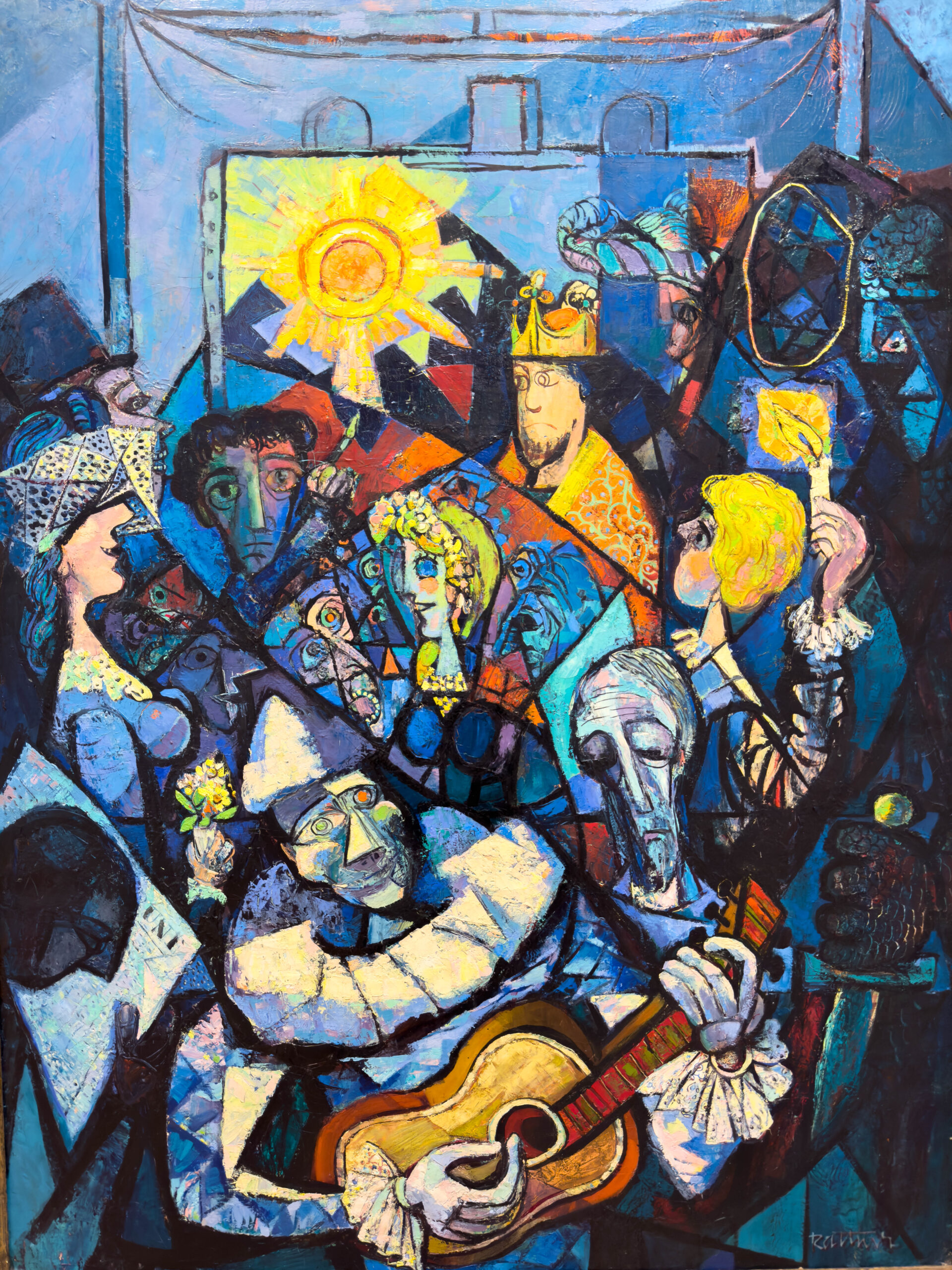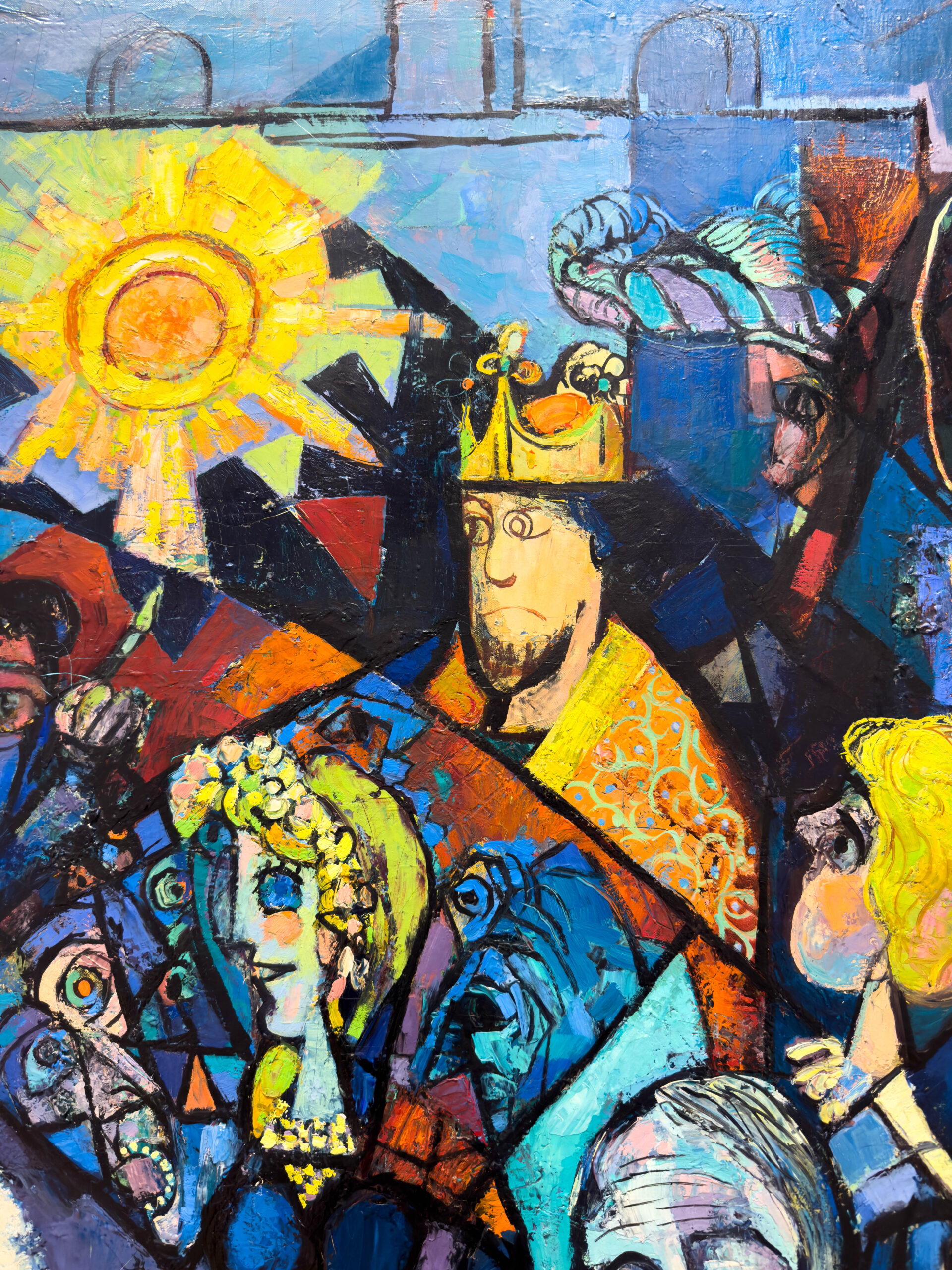Clowns and Kings

General Description

General Description: General Description: Artist: Abraham Rattner (American, 1893–1978)Title: Clowns and Kings (1944)Medium: Oil on canvas, 51 ¼ x 38 ¼ inchesCollection: Leepa-Rattner Museum of Art, St. Petersburg College, gift of the Tampa Museum of Art, Allen Leepa and Abraham Rattner Collection, 2021.1.001Overview: Clowns and Kings is widely recognized as one of Rattner's masterworks and exemplifies his use of figurative expressionism, a style where emotional and symbolic content is expressed through the human figure. Painted during the intense period of World War II, the work reflects Rattner's inner turmoil and response to the global conflict. The painting employs a flattened perspective, achieved through overlapping heads, faceted planes, and interwoven lines, giving the viewer the sense of chaos and complexity. Iconographically, the painting is populated with symbolic figures, each of which carries emotional and philosophical significance, including a clown, a Christ-like figure, a king, and a self-portrait of the artist.
https://stpetearmachine.com/wp-content/uploads/2024/12/general-description-1366491768-1733510823.mp3
Interesting Facts

Historical Context and Rattner’s Response to World War II:Clowns and Kings was painted in 1944, during the final years of World War II. At this time, the world was grappling with the horrors of the Holocaust, the devastation of cities through aerial bombings, and the looming use of the atomic bomb. The painting reflects Rattner’s response to these global events, particularly his deep disillusionment with humanity’s capacity for cruelty.Rattner’s comment on the painting, "Our dreams, our hopes, aspirations, strivings, struggles, anxieties, disillusionments, and the great silence," suggests that the figures in the painting are not just characters, but representations of human emotions and existential questions. The work speaks to the alienation, suffering, and search for meaning that many experienced during the war.Evolution of Rattner’s Artistic and Philosophical Beliefs:During the early 1940s, Rattner underwent a profound shift in both his artistic style and his philosophical outlook. As he noted in his diaries, he had "lost interest in cubist (and surrealist) expression when the ghastly presence of Hitler and his bloodletting hideousness shadowed the human horizon... The trust I once had was outraged." This shift led him to abandon the curvilinear forms of his earlier work in favor of more structured, emotionally charged compositions that conveyed his anguish over the war.Rattner’s strong patriotism and sense of duty were stirred by the events of World War II. In 1940, at the age of 47, his feelings of rage at the attack on Pearl Harbor and his relief that the U.S. would finally take action against the Axis powers were a turning point for him. These emotions are reflected in the intensity of his wartime paintings, which moved away from the prevailing trends of American regionalism and abstraction in favor of a more expressive and narrative-driven approach.Personal Reflections on the War:Rattner kept detailed diaries, letters, and scrapbooks throughout the war, documenting his emotional responses to major events:The Nazi invasion of France in 1940 filled him with despair over the selfishness of leaders, remarking that they loved "their wealth, their power more than their country."The attack on Pearl Harbor in 1941 left him enraged by the treachery but relieved that the U.S. would finally "wake up, unite, and act."Rattner was deeply disturbed by reports of the Japanese slaying of Chinese civilians and the unfolding Holocaust against the Jews. His writings reflect a profound sense of nausea and disbelief at the scale of human cruelty, as he grappled with the reality that over six million Jews were being exterminated.As the tide of the war turned, Rattner expressed hope and optimism in his writing, especially after key events such as the Allied invasion of North Africa and the liberation of Paris. These victories seemed to signal the end of the war and the downfall of Hitler’s regime.Impact on Rattner’s Artistic Legacy:Clowns and Kings is a key work in Rattner’s oeuvre, encapsulating the emotional and philosophical turmoil he experienced during the war years. The painting’s combination of personal reflection, symbolic imagery, and historical context makes it not only a testament to Rattner’s artistic evolution but also a powerful commentary on the human condition during one of the darkest periods in modern history.
https://stpetearmachine.com/wp-content/uploads/2024/12/interesting-facts-1105435174-1733510951.mp3
Highlights
Composition and Symbolism:Clowns and Kings features an eclectic cast of characters, each imbued with symbolic meaning. Rattner’s choice of figures illustrates both personal introspection and his broader reflections on humanity during wartime:The clown, a recurring figure in Rattner’s work, plays a guitar without strings. This detail signifies isolation and the inability to communicate, perhaps reflecting a society that is disconnected from the suffering around it. The clown is a symbol of entertainment and folly, yet the absence of strings suggests a deeper, melancholic silence in the face of tragedy.A gaunt Christ-like figure appears in the scene, a reference to sacrifice and redemption. Rattner often invoked religious imagery, and this figure may symbolize both the suffering endured by humanity during World War II and the hope of eventual salvation or rebirth after the war’s devastation.IMG_9394The bewildered king, portrayed with confusion or disillusionment, may represent the loss of direction among global leaders or the failing political structures that allowed the rise of fascism. The king's helplessness reflects Rattner's own critique of those in power who, he felt, were too detached from the realities of human suffering.IMG_9392The artist, depicted wide-eyed and likely a self-portrait of Rattner, is shown painting the sun. This act symbolizes hope amidst the chaos, suggesting that despite the turmoil of the world, the artist can still create light and offer vision for a better future. This self-referential aspect highlights Rattner’s role as both an observer and a participant in the social and philosophical discourse of his time.IMG_9393The boy holding a candle may symbolize an attempt to bring awareness or illumination to the dark events unfolding around her, while the woman with a veil over her eyes represents blindness or ignorance, suggesting a willful refusal to see the atrocities of the war.IMG_9395

